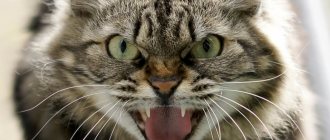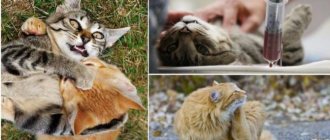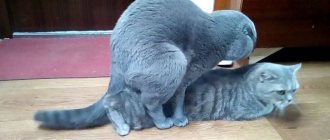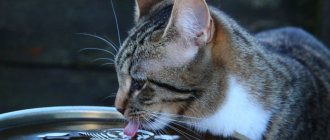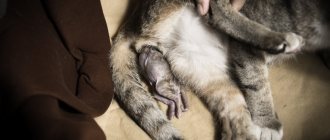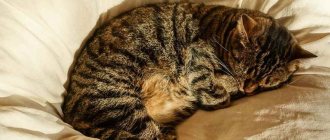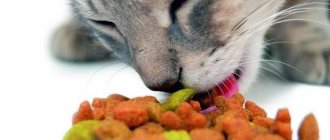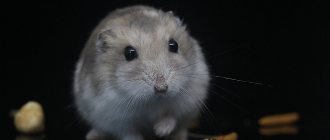, Where poly
- many,
cystis
- cyst - a hollow tumor with liquid contents) is a disease in which many cysts form in the kidneys. Over time, most of the kidney becomes a vesicular formation. This disease develops in both kidneys simultaneously, and the function of the kidneys to cleanse the blood of waste products is sharply reduced.
A veterinarian might write a diagnosis like this: “Autosomal dominant feline polycystic kidney disease (ADPKD).” In English, the disease sounds like Polycystic kidney disease (PKD).
Unfortunately, polycystic kidney disease is the most common inherited disease in cats. Cats of the Persian breed get sick most often - up to 38% of representatives worldwide! The risk group includes breeds in which the Persian cat was used: British Shorthair, Scottish Fold and Himalayan cat, as well as a number of related breeds (see table).
Table The incidence of polycystic kidney disease in different breeds of cats (according to the Russian Society of Veterinary Urologists)
Causes of the disease
Veterinarians attribute the hereditary predisposition of some animals to the only cause of polycystic disease. The mechanism for the development of pathology is as follows: a certain gene responsible for protein synthesis is mutated. As a result, a cyst forms, growing and affecting healthy tissue. The infected gene can be passed on to a kitten by both the mother and the father. If both parents are carriers of it, then at conception the two infected protein genes combine and the offspring die in the womb.
If the kitten survives, then for a long time it gives the impression of being absolutely healthy, since the disease does not manifest itself in any way. Meanwhile, the pathology has already begun its destructive effect. Polycystic disease cannot be cured. The veterinarian’s task is to use treatment to stop the destructive process and thereby prolong the life of an animal with defective kidneys.
What to do if your cat has polycystic kidney disease?
An important system in both humans and animals is the excretory system. The kidneys remove toxins from the body. Any disease affecting this system is very dangerous. Veterinary practice can expand on the topic of polycystic kidney disease in cats, and also notify the owner of a furry pet that the disease requires immediate treatment. There is no point in delaying it - the disease is serious, the consequences are irreparable.
What is this disease? This means that the renal parenchyma is replaced by many cysts formed. They put strong pressure on the kidneys, and this will sooner or later lead to a decrease in their functional ability, neurosis and nephritis. Often the disease develops into nephrosclerosis.
A cyst is a kind of bubble formation filled with liquid, or vice versa, in the form of a dense substance. A renal cyst can develop both in the area of the nephron and where the renal tubules are located. Often, in both cases, two organs of the animal’s excretory system are affected.
Polycystic disease does not mean immediate death for your furry friend, but it should be treated as soon as it is discovered by your veterinarian. This disease may be followed by sepsis, since the cystic disease predisposes the body to a secondary bacterial infection. Polycystic disease also causes severe intoxication of the entire body.
The disease can affect any breed of cat, regardless of the gender, age, or physiological state of the animal. But there are the most predisposed:
- Persian longhair,
- Himalayan
- Scottish fold cat
- exotic shorthair cat.
It is unknown how long a cat with polycystic kidney disease will live, but it must be treated immediately. Persian cat breeds suffer from this disease. And often, a three to five year old animal is left without kidneys, in the full sense of the word. There is a tendency that purebred cats have a greater risk of getting sick than ordinary domestic cats. British cats suffer from diseases less frequently than their Persian counterparts. But don’t be surprised, because they are relatives.
Some experts in veterinary medicine have proven that parathyroid hormone and vasopressin activate the growth and formation of cystic accumulations. But these assumptions are not fully substantiated.
Symptoms and diagnosis
What are the symptoms of the disease in the presence of pathologies? It is very difficult to determine the initial stages of the disease, one might say impossible. When the cysts greatly increase in size, they cause pain, the abdominal cavity becomes larger, and then the animal begins to suffer and the owner clearly notices this in the behavior of the furry friend. But when simple papation reveals many cysts, it is often too late and the only way out is to remove the kidneys completely.
Since the exact cause of polycystic kidney disease is unknown, there are no preventive measures that could prevent its development. Breeders have been trying to solve the problem for a long time by selecting only “pure” animals for breeding, but... Due to the fact that at least 40% of the Persian population is susceptible to this pathology, this will take a very long time.
In addition, selective breeding can reduce genetic diversity, increasing the already considerable number of unwanted defects characteristic of that breed. Therefore, all owners of Persian and British cats can only be advised to visit veterinarians more often for a complete, comprehensive examination of their pets.
A proper diet can help improve your pet's quality of life. Compliance with it is extremely important. Experts recommend using specialized medicinal feed (Hills and the like). If this is not possible, light food (preferably broths); the cat should not be given fatty, excessively high-calorie foods. It is advisable to completely exclude fish, and good chicken (boiled) from meat.
The owner must follow the veterinarian's instructions. You cannot prescribe medications yourself, reduce or increase the dosage of medications!
Dietary nutrition is of great importance in the treatment process. Veterinarians recommend special medicinal wet food intended for animals with kidney pathologies. Such feeds are characterized by compositions with a reduced content of protein and phosphorus. It is these elements that provoke the development of symptoms of chronic renal failure.
Common diseases
Kidney diseases pose a great danger. When there are serious problems, there is always the possibility that the animal may die.
Table. Common kidney diseases in cats
| Name of the disease | Emerging problems |
| Chronic failure | The gradual destruction of an organ, as a result of which the activity of the entire organism is disrupted. Stays with the animal for its entire life. Pet owners can only carry out constant maintenance therapy, avoiding exacerbation of the disease. The impetus can be any unfavorable factors (hypothermia, inflammatory diseases, metabolic disorders, etc.) |
| Acute failure | Unforeseen inflammatory process. There is a violation of the functions performed by organs. It develops rapidly and poses a greater danger than the chronic form. Common causes of the problem: heart disease, shock, drop in blood pressure, urolithiasis |
| Pyelonephritis | An inflammatory process of a bacterial nature. A common source of the problem is diseases of the genitourinary system |
| Nephritis | An inflammatory disease that affects the glomeruli, tubules, and interstitial renal tissue |
| Hydronephrosis | Enlargement of the pyelocaliceal system, destruction of the renal parenchyma. As a result, a pathological process develops, blood circulation is disrupted, and the outflow of urine worsens. All functions of the kidney cease to be performed properly. The problem can be primary or secondary. In the first case, the cause is the presence of congenital pathologies (for example, ectopia of the ureter). In secondary hydronephrosis, problems arise due to systemic diseases (urolithiasis, tumors, etc.) |
| Nephrosclerosis | The tissue of part of the kidney or the entire organ is replaced by connective tissue. There is a gradual death of kidney cells - nephrons. As a result, the organ greatly decreases in size, shrinks and hardens. |
The structure of a cat's kidney
Keeping a sick animal
Pets with this diagnosis do not require special living conditions. It is important to follow the diet prescribed by your veterinarian. It is best to feed your four-legged pet with ready-made medicated food. If this is not possible, let’s use a natural diet. It should not contain too high-calorie, fatty foods. Free access to clean drinking water around the clock is an important point.
The owner of a sick cat needs to monitor his drinking regime. If he drinks little water, it is recommended to switch him to canned wet medicated food. The animal must be shown to the veterinarian monthly in order to promptly identify the deterioration of its condition and take appropriate measures.
Symptoms and treatment of polycystic kidney disease in cats
Polycystic kidney disease in cats is a hereditary disease in which there is a proliferation of fluid-filled cysts in the animal's kidneys. Certain breeds of cats are predisposed to this disease. This pathology affects two kidneys at once, resulting in a decrease in the quality of blood purification by infected organs.
The following cat breeds are most often affected by polycystic disease:
- exotic shorthair;
- Persian;
- Himalayan;
- Scottish lop-eared;
- mixed breeds of the above breeds.
The complexity of the disease lies in the fact that the process of kidney damage by cysts is irreversible and it is constantly progressing. The size of the formations increases throughout the animal's life, leading to the development of renal failure. Although polycystic disease cannot be cured completely, therapeutic methods can slow down its progression if detected early.
- renal failure;
- intoxication of the body;
- infection of the body by bacteria;
- sepsis;
- transformation of cysts into malignant neoplasms;
- death.
We invite you to read: British Highlander cat features
Despite the fact that polycystic disease most often affects purebred cats, any cat can suffer from this disease, regardless of breed, age and physiological characteristics.
Causes of pathology
This disease has been known in medicine for more than 30 years. Unfortunately, the only cause of polycystic disease identified to date is a hereditary predisposition of individual individuals. According to research, the disease develops as a result of a mutation in a certain gene responsible for protein synthesis. As a result of this process, a cyst is formed, which grows and replaces healthy tissue.
A kitten can receive the infected gene from both its mother and father. During conception, a combination of two defective protein genes occurs. In this case, the embryo dies in the womb.
Until the age of 7 years, the presence of polycystic disease does not manifest itself in any way, since the process of replacing kidney tissue with cysts is very slow. Over time, the functionality of the kidneys is impaired, which has a detrimental effect on the animal’s excretory system and the entire body as a whole.
Upon reaching 7 years of age, as a rule, cysts grow in size and affect most of the tissues of both kidneys, thereby significantly reducing the functionality of the organs. It is at this time that symptoms of polycystic disease begin to appear, which resemble signs of kidney failure.
Kidney functions
The kidneys perform the following functions:
- remove water and salts;
- remove toxic substances formed in the body or included in medications;
- maintain constant metabolism;
- maintain a constant blood reaction.
Location of the kidneys in a cat
Prevention
When crossing a sick individual with a healthy one, the probability of giving birth to infected kittens is 50%. Therefore, it is better to spay or neuter pets with polycystic disease to prevent further spread of the disease. If an animal has sick relatives, it must be systematically examined to exclude manifestations of the disease.
Preventive examinations of cats will help identify health problems in the early stages, thereby reducing the risk of severe complications.
Diagnostic methods
The initial stage of the disease can be detected by a veterinarian when examining a pet.
In the early stages, it is possible to diagnose polycystic disease in cats only in a veterinary clinic, since there are no obvious symptoms of kidney disease or are mild. The veterinarian conducts a visual examination of the pet and finds out from the owners what signs are bothering the pet and for how long. To make an accurate diagnosis, the following diagnostic procedures are required:
- biochemistry and general laboratory blood testing;
- stool analysis;
- kidney biopsy, in which a small piece of damaged tissue is sent for histology;
- Ultrasound diagnostics of cat kidneys;
- x-rays of the paired organ to identify cysts in it;
- sowing samples of diseased tissues on a nutrient medium to detect bacterial infection;
- genetic tests.
Basic information and predisposing factors
What it is? This is the name of the phenomenon in which most of the renal parenchyma is replaced by multiple cysts. They put significant pressure on the organ, which gradually leads to a decrease in its functionality, nephrosis and nephritis. Sometimes it ends in nephrosclerosis. A cyst is a kind of “bubble”, the contents of which can be liquid or a dense substance.
We suggest you read: How to stop a cat from shitting in the wrong place, reasons and practical tips
Although polycystic disease does not usually cause immediate death to the animal, it must be treated immediately after detection. The fact is that it can lead to sepsis; cysts make the body predisposed to secondary bacterial infections, and severe intoxication (due to loss of kidney function) should not be forgotten.
In general, polycystic kidney disease in Persian cats and crossbreeds based on them is almost a universal phenomenon. It is not uncommon for a three to five year old cat to have virtually no kidneys left in the normal sense of the word. Unfortunately, the more purebred the animal, the greater the risk to its life and health. Thus, polycystic kidney disease in British cats is slightly less common than in Persians. However, it is not surprising: the “British” are their relatives...
What are the causes of this pathology? Firstly, this is a hereditary disorder, characteristic, as we have already said, of the same Persians. Alas, other factors that stimulate the development of cysts have not yet been identified. One can only assume that hereditary factors and diseases of the endocrine glands also play an important role in this process.
The process of tissue replacement is very long and slow, so you can suspect polycystic disease in a cat no earlier than when he reaches 7 years of age. By this time, the cysts increase in size and occupy most of the kidneys, limiting their activity.
The owner should be alert to such signs as:
- lethargy, low mobility;
- depressed state;
- weight loss associated with food refusal;
- vomit;
- frequent urination;
- increased thirst.
As the disease progresses, the symptoms become more pronounced and the pet’s condition worsens.
Causes of problems
Often it is not possible to determine the reasons why the disease occurred. The most common reasons:
- age (cats from 7 years of age are most susceptible to diseases, so it is necessary to conduct their annual full examinations: blood test, urine test, ultrasound, blood pressure measurement);
- genetic predisposition (the presence of similar problems in representatives of a certain breed to which the animal belongs);
- congenital anomaly;
- ecology;
- infectious diseases;
- systemic diseases;
- poisoning;
- injuries;
- poor nutrition;
- negative processes in the urinary canals (the problem is more common in cats, since their canals are longer and narrower than those of cats).
Cats over 7 years of age are most susceptible to diseases, so it is necessary to conduct their annual full examinations.
Predisposing factors that provoke kidney diseases:
- lack of fluid consumed by the animal;
- drinking contaminated water;
- excess salt contained in the feed;
- Exceeding the required amount of sugar in the diet;
- frequent feeding of meat and fish;
- large mass;
- lack of weight;
- keeping in dampness, in drafts;
- sedentary lifestyle;
- untimely urination (occurs when an animal is periodically unable to go to the toilet on time due to closed doors or dirty litter);
- oral problems.
Kidney diseases in cats and kittens
Important information for the owner
Polycystic kidney disease, unfortunately, is incurable. There is currently no real way to slow down the growth of cysts. Also, you cannot remove or puncture bubbles with liquid. Therefore, the owner must direct maximum efforts to ensure a painless and comfortable life for the pet.
To understand exactly how to help a pet with a terrible diagnosis, you need to understand the mechanism of kidney function. The vital paired organ helps control blood pressure by secreting a unique enzyme called renin. When blood pressure drops and organs don't get enough blood, renin is released, causing blood vessels to constrict. Once the blood vessels narrow, blood pressure will rise. Healthy kidneys filter toxins and excess water from the blood. Purified blood remains in the body, and waste leaves the body through urine. The kidneys also help maintain the proper balance of vitamins and minerals in the blood, including sodium, calcium, potassium and magnesium. But as the cysts grow, all of the above kidney functions will deteriorate significantly.
Therefore, it is important to reduce the level of toxins in your cat's body. You need to make sure that your pet does not come into contact with sick pets, eats simple but nutritious foods, and is also vaccinated against the most common infectious diseases. It is imperative to ensure that the animal’s diet contains foods low in protein and phosphorus. Of course, cats need protein for normal growth, muscle building and rapid repair of damaged tissue. But after the body processes the incoming protein, a waste product called urea is formed. Cats with kidney failure cannot quickly and without consequences completely get rid of this processed product.
Insidious organ
Any disturbance in ensuring normal metabolism and removal of excess substances from the body leads to systemic pathologies. And here it is important to know that kidneys, like no other organ, are disposable items. The number of nephrons in a kitten’s kidney is determined from birth, and they can only die, but cannot regenerate.
Another feature of the structure of the kidneys is that they do not contain pain nerve endings. That is why, when they begin to make themselves felt, this indicates an already mature pathology.
Here 10% of nephrons died - the cat is healthy, 20% - unchanged. And 50% of the nephrons died, and the animal got sick. And if more than 70% of the nephrons of the kidneys die, the prognosis of the disease is very disappointing.
How does the disease progress?
A kitten that inherits a mutated gene from one of its parents appears healthy when it is born. Despite the absence of any manifestations, this disease begins its destructive effect from the first days of the animal’s life. It progresses so slowly (over several years) that its symptoms only become apparent once the pet reaches adulthood.
Diagnostics in a veterinary clinic
What are the symptoms of this pathology? Alas, it is almost impossible to determine it in the initial stages. Until the masses become too large, causing pain and enlargement of the abdominal cavity, nothing noticeable can be noticed. Most animals initially show no clinical signs at all.
Sometimes hematuria is observed in cats. In polycystic disease, this indicates an advanced stage of the disease and strong pressure on the organ, which caused the appearance of blood in the urine (if anyone doesn’t know, hematuria is blood in the urine). Of course, this symptom can hardly be called at least somewhat specific, since it may indicate some kind of blood parasitic disease or leptospirosis.
The danger of this pathology is that cysts often do not cause any pain reaction, and therefore the cat remains calm, its behavior does not change in any way. Experienced veterinarians may suspect something is wrong based on urine tests and deep palpation of the abdominal cavity. To confirm the diagnosis, a biopsy may be used, which, among other things, will determine the exact nature of the cysts and their danger to the cat's life.
Often, tissue samples obtained during a biopsy are used for seeding on nutrient media: this way, the presence of a secondary bacterial infection can be excluded or refuted and the most suitable antibacterial agent can be immediately determined that will help in this case. Arterial hypertension or high blood pressure is a subtle, but still a sign of kidney problems.
To make a diagnosis, a veterinarian needs to conduct a series of tests. Clinical signs are studied, in-depth palpation with the abdominal chamber, urine analysis, and biopsy are performed. With the help of these studies, the nature of the cysts and the degree of their danger to the life of the animal are established.
An ultrasound examination is performed to determine the tumor and the ratio of modified and intact tissue in the kidneys.
X-rays can reveal polycystic disease only at the final stage.
Treatment
General treatment of kidney diseases is carried out in the following areas:
- Elimination of factors and diseases that caused the problem.
- The use of medications prescribed by a veterinarian, taking into account the age, weight, nature of the disease, and stage of the animal’s disease. Systematic use of correctly selected drugs will help stabilize the condition and prevent active progress.
- Use of antibiotics. Antibiotics are prescribed if an infectious process occurs. Antibacterial drugs help suppress the activity of harmful microorganisms that were the source of the development of the pathological process.
- The use of droppers. Special solutions are introduced into the animal’s body, which allow the correction of pathological processes. When dehydrated, the required amount of fluid is restored.
- Compliance with the prescribed diet. Animals with kidney problems need to eat special food. The level of nutrients in these feeds corresponds to the required norm.
Treatment can be carried out using droppers
Kidney failure
It is always necessary to promptly contact a specialist for diagnosis and treatment. In the acute form, it is important to quickly identify the factor that triggered the development of the process and eliminate this factor. For example, if you have urolithiasis, it is impossible to relieve the symptoms of kidney failure without treating this problem. The main methods of treatment used in the acute form:
- Intravenous injections (“Sulfokamphokai”n). Helps restore water balance and relieve symptoms of intoxication.
- Diuretics (Temisal, Diacarb). When there is insufficient amount of urine excreted relative to the fluid consumed.
- Symptomatic treatment: for vomiting - antiemetics (Papaverine, Cerucal, Enterosgel), for elevated glucose levels - insulin, etc.
- Hardware hemodialysis. Hardware blood purification, which allows you to prolong the life of the animal.
- Surgical intervention. If all of the above treatment methods are ineffective, the diseased organ is removed and a healthy one is transplanted.
The drug "Eufillin"
Treatment for the chronic form includes:
- Regular checks (blood, urine). If deviations are detected, additional diagnostics are carried out and the prescribed systematic treatment is adjusted.
- Use of infusion therapy (administration of solutions).
- Taking vitamin and mineral preparations (Polidex, Beafar, Anivital Feliimmune).
- Use of nutritional supplements (“Feliimmune”).
- Application of phytotherapeutic methods. Ready-made mixtures and preparations based on medicinal herbs are highly effective along with a low level of side effects.
- Hardware hemodialysis.
- Surgical intervention.
"Feliimmune" to support the immune system of cats
The prognosis in the chronic and initial stages of the disease is quite favorable. If you follow doctors' recommendations regarding diet and use of prescribed medications, the animal's life can be extended for a considerable time.
Important! In the acute form of the disease, the prognosis is unfavorable. The likelihood of death is very high.
Pyelonephritis
Treatment regimen:
- painkillers (“No-shpa”, “Baralgin”, etc.);
- perinephric block;
- a course of antibiotics (“Penicillin”, “Carbenicillin”, “Amoxicillin”, etc.);
- a course of sulfonamides (“Sulfadimethoxine”, “Sulfen”, etc.);
- chemical diuretics (“Diacarb”, “Eufillin”);
- herbal diuretics (rose hips, calendula);
- droppers.
The drug "Diacarb"
Nephritis
Treatment regimen:
- chemical diuretics (“Temisal”, “Eufillin”);
- herbal diuretics (lingonberry leaf, bearberry);
- sedatives for heart failure (digital infusion, strophanthus infusion);
- iron preparations and vitamins (“Cyanocobalamin”, “Ferroglukin”, “Campolon”);
- strengthening agents - for diarrhea;
- laxatives - for constipation.
"Cyanocobalamin"
Hydronephrosis
For minor damage:
- catheterization;
- washing the urethra and bladder.
In more serious cases, surgery is performed.
Nephrosclerosis
Treatment is aimed at eliminating the underlying disease. Applicable:
- cardiac drugs (cardiac glycosides, drugs with potassium, anticoagulants);
- diuretics (“Eufillin”, “Temisal”, “Diakarb”);
- glucose therapy;
- laxatives, antiseptics (for intestinal intoxication);
- antibiotics.
Diuretic Eufillin
What types are there?
Symptoms of polycystic disease in cats may vary, depending on the type of disorder. The table shows the main classification of the pathological process in the animal’s kidneys and a brief description:
| View | Peculiarities |
| Unilateral | The left or right internal organ is affected |
| Symptoms may not be observed for a long time, since one kidney functions normally and takes over the work of the patient | |
| The prognosis for this form of polycystic disease is more positive | |
| Double sided | Cysts form in both kidneys at the same time |
| In cats and cats, the process of urine excretion is completely disrupted | |
| Rapidly progressive intoxication of the body is noted | |
| This type of disease occurs with pronounced symptoms. |
How to recognize the symptoms?
With this disease, animals drink a lot of water.
The prognosis for polycystic kidney disease in a cat depends on how quickly the disease is diagnosed. In the early stages, pet owners may not notice any changes in behavior, and the pathology continues to rapidly progress. When the cysts become very large, lumpy protrusions are observed in the abdominal cavity of the cat. There are other symptoms characteristic of polycystic kidney disease:
- lethargic state and reluctance of the animal to take part in active games;
- strong thirst that is difficult to quench;
- increased excretion of urine;
- gagging;
- loss of cat body weight;
- poor appearance of the coat, including possible hair loss;
- reduced hemoglobin in a pet;
- uncontrolled emptying of the bladder;
- muscle weakness and coordination problems;
- strong pain;
- blood in the urine.
If you do not pay attention to the pet’s unpleasant symptoms, then kidney failure will soon occur and the cat’s early death is possible.
Polycystic kidney disease in a cat, treatment does not help
The British have a predisposition to polycystic disease. It is often accompanied by chronic renal failure. These diseases cannot be cured, but help to stabilize can and should be done. But first, a normal diagnosis of the animal’s condition is necessary.
Is that all from the analyses?
Also needed: 1. general blood test with leukemia formula, 2. normal blood biochemistry (not two indicators, but expanded, and with electrolytes), 3. general urinalysis with sediment microscopy and protein/creatinine ratio in urine.4. Be sure to measure your pressure.
Depending on the results of the examination, maintenance therapy is prescribed.
Treatment method and prognosis
Treatment of polycystic disease is complex, including surgery. Conservative therapy does not produce results.
If the disease is detected at the initial stage, there is a chance to cure the animal, however, as practice shows, such cases are very rare. As mentioned above, polycystic disease occurs in a latent form for many years and diagnosis is carried out already at the second or third stage of the disease.
If the cysts occupy a large area and are large in size, the fluid is periodically removed from them using a puncture needle. To minimize chronic renal failure developing against the background of polycystic disease, drug therapy is indicated.
In order to prevent intoxication, rehydration detoxification is carried out - parenteral administration of rehydration solutions to remove toxins.
Stabilization of blood pressure is achieved with the help of the drug Amlodipine, as the most effective. The dosage and course are determined by the veterinarian.
Gastroprotectors are used to relieve decreased production of gastric juice, eliminate attacks of vomiting and prevent stomach ulcers.
Prevention of anemia is carried out through the use of the drug Erythropoietin.
If during the diagnostic process, namely bacterial culture, secondary microflora was detected, antibiotic therapy is indicated for the animal. Preliminary tests are carried out to determine the sensitivity of microflora to antibiotics.
As for the prognosis, veterinarians are cautious about it. The lifespan of animals with polycystic disease varies from two months to several years. When implementing maintenance therapy at the initial stage, the prognosis is favorable, in other cases it is negative or doubtful.
Treatment: how is it carried out?
It is impossible to completely cure polycystic kidney disease in a cat, but the prognosis can be improved and the pet’s lifespan can be extended with the help of drug therapy and other treatment methods selected by the veterinarian. The sooner a cat’s cyst is identified, the higher the chances of a favorable outcome. At the initial stages, when the cystic formations are small, an operation is performed to remove the diseased area. In a later period, such a measure is not possible and effective. In this case, medications are selected to help improve the quality of life of a pet with polycystic kidney disease. Approximate medications are listed in the table.
| Group | Pharmaceuticals |
| Phosphate binders | "Ipakitina" |
| "Calcium carbonate" | |
| Angiotensin-converting enzyme blockers | "Captopril" |
| "Kapoten" | |
| "Ramipril" | |
| "Lisinopril" | |
| Direct acting renin inhibitors | "Enalkiren" |
| "Remikiren" | |
| Hormones that regulate red blood cells | "Erythropoietin" |
Certain medications will prevent hypertension from appearing in an animal.
Cats need to be given vitamins of group D. To avoid signs of hypertension, it is recommended to include special medications in the treatment of polycystic kidney disease. In addition to drug therapy, the affected pet will need to regularly have fluid drained from the cyst using a special needle.
Equally important is monitoring the cat’s diet, which should include foods containing phosphorus and protein. Thanks to this diet, it is possible to stop intoxication of the body and kidney failure.

